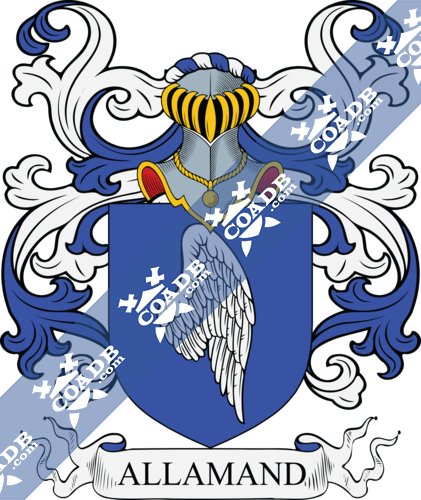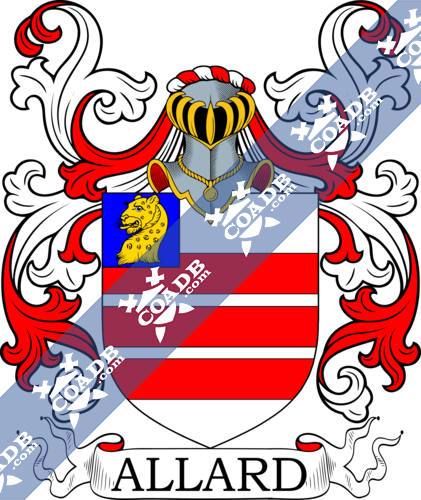Allan Family Crest, Coat of Arms and Name History

Allan Coat of Arms Gallery
Don’t know which Coat of Arms is yours?
We can do a genealogical research. Find out the exact history of your family!
Learn MoreALLAN
The surname Allan is of Celtic origin and is believed to date back to antiquity. It is derived from the ancient Gaelic “ailin”, which translated to English means “little rock”. The name was thought to have been introduced into England by the followers of Sir William de Clare, also known as “Strongbow” during and after the Norman invasion of Ireland in the late 12th century.
Surnames in Britain prior to the Norman conquest were largely unheard of. In the small settlements and villages which existed during earlier times, residents found little need for surnames as everyone in these communities new each other and a given name would usually suffice. However, with the passage of time, population growth and expansions of communities as villages gave way to towns and cities, it became necessary to add a qualifier to a people’s names to distinguish them, one from another. Therefore one person may have been identified by their given name plus their occupation while another may have been identified by their given name and one of their parent’s names. The introduction of surnames by the Norman aristocracy after the invasion seemed to be the next logical step in this evolution. There was a boundless supply from which surnames could be formed, in addition to the use of patriarchal/matriarchal names or reference to the individuals occupation, there were things such as defining physical traits, a familiar geographical location or a topographical landmark found near the individuals home or birthplace, the name of the village in which the person lived, and so much more. Soon, surnames would come not just to represent an individual but whole families.
There often exists variations in spelling of many surnames, as with many given names which date back to the early centuries. The variation in spelling of both given and surnames during this time period can be attributed to a lack of continuity regarding guidelines for spelling which was compounded by the diversity of languages in use in European countries at this time. The variations in the spelling of the surname Luke include but not limited to; Allan; Alan; Allen ; Allain; Allaine; Alleyn; and Allanshaw among others.
The earliest record of any variation of this surname is that of Geoffrey Alein which appears in Cambridge tax rolls from 1234. These rolls, were a series of census and tax records kept by the English Treasury by order of King Henry III, with the oldest dating back to the 12th century. They hold the distinction of being the oldest consecutive set of records detailing English governance in the United Kingdom. These records span a period of over seven hundred years.
One of the first recorded immigrants to America bearing the surname or any variation of the spelling was John Allan who arrived in 1622 and settled in Virginia. James Allan landed and settled in Virginia in 1685 and William Allan arrived and settled in New Jersey in 1685.
There were also many immigrants to the British Common Wealth countries of Canada, Australia, and New Zealand bearing the surname. Thomas Allan landed in 1749 and settled in Nova Scotia, Canada as did Nathan Allan in 1750. William Allan landed in 1825 and settled in New South Wales, Australia. John Allan landed and settled in Adelaide, Australia in 1840. John Allan landed in 1841 and settled in Wellington, New Zealand. Agnes Allan landed and settled in Nelson, New Zealand in 1842.
Worldwide, the highest concentration of people with the surname Allan are found in New Zealand, Australia, the United Kingdom, Canada, and the United States. By state, the largest percentile of those with the surname Allan live Utah.
There are many persons of note who bear the surname such as British born painter and politician, Sir Alexander Allan. He was a Member of Parliament and director of the East Indian Company from 1814 until 1820. Allan was created a baronet in 1819. As he never married and had no heirs, the title became extinct upon his death in 1820.
British born artist, Rosemary Elizabeth Allan, was noted for her work in watercolors. She had multiple shows at the Royal Academy, New English Art Club, and the London Group. Many of her watercolors are on permanent display at the Imperial War Museum in London.
Blazons & Genealogy Notes
First notation: From England, indygenat XVIII Century W polu srebrnym dwa pasy faliste niebieskie, w głowicy barwy ostatniej złota gwiazda pięcioramienna między muszlami barwy pierwszej. Klejnot: medalion owalny z głową psa, barwy naturalnej.







